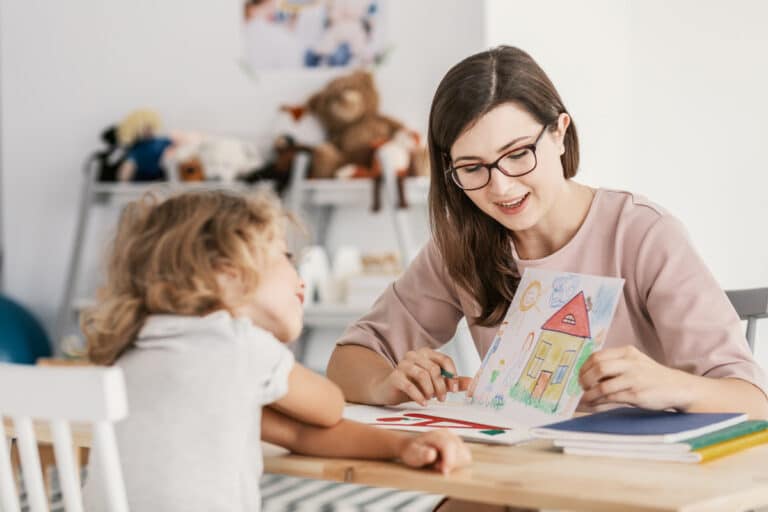A lot of people know identify shapes like circles, squares, and triangles. But when do kids start learning process about these shapes? And what are the benefits of knowing them? Kids typically get basic understanding about the shape at around 2 years old. Learning shapes is important for a child’s development because it helps them recognize objects in different ways from how they look or from what they sound like.
According to a study done by the University of North Carolina, child learn shapes from about 2-4 years old. Children learn the shape names and what it looks like before they can identify that new shape in real life. There are many different types of shapes, including geometric more advanced shapes (circle, square) and organic shapes (apple, leaf).
You can help your child learn about shapes by drawing them on paper or using them as part of playtime activities. When you’re out exploring nature with your kids, point out natural objects with interesting shapes to keep their interest piqued. Kids might not be able to recognize all the different types of angles at first. Triangles seem to be easier for most children than parallelograms – but over time they will become more familiar with each one.
Learning shapes is an important skill for kids of all ages. It’s not just about learning to recognize the shape, but also how they are used in everyday life. A great way teaching toddlers shapes is by using toys and games that you can buy at many toy stores.
What are shapes?
Shapes are commonly found in our everyday lives. From the shape of a square to circles, triangles, and rectangles; same shape can be seen anywhere! But what is a shape? A shape is defined as any two-dimensional (flat) area bounded by straight lines or curves. There are six shapes: triangle, rectangle, square, circle, oval, and diamond.
Children love shapes because they offer so many opportunities for creativity. They can play with their food on their plate to create new shapes or use them to build something funny different shape like an animal’s house! They also enjoy looking at pictures of animals that have geometric bodies made up of just one or more shapes such as circles for eyes and ovals for ears.
Shapes are the building blocks of all things around you. They come in a variety of shapes, sizes, and colors. There are shapes that everyone is familiar with such as squares, circles, and triangles. However, there are many more complex shapes like pentagons or hexagons which we know as stars!
Why should kids know shapes?
Kids should know shapes because it will help them in the future. If they can identify and name all the different shapes, then they will be able to understand math better since many of the equations and formulas use shapes. When children build with blocks, they’ll also want to make sure that they are using the right shape for what they’re trying to make!
Kids should know shapes because it’s important for spatial reasoning skills. Learning about geometry is an important part of understanding how things work in our world and make kids smarter when it comes to figuring out puzzles or anything else that requires problem-solving. They might even get a head start on understanding architecture! They even learn classify objects, match objects to two identical images and develop fine motor skills.
Children need to know shapes as early as possible. In school, they’ll be learning about shapes and how to identify them. Before that happens though, parents should teach their kids how to recognize the basic ones like circles, squares, triangles, and rectangles. There are a lot of benefits for children who learn about shapes before kindergarten – they can use them in everyday life with problem-solving tasks. If you have a toddler at home or someone who is just starting preschool next year, its best time to introduce your children to shapes!
Why is it important to teach children about shapes?
It’s important to teach children about shapes because it helps them develop their cognitive, spatial, and mathematical skills. A child can explore the world around themselves better with knowledge of shapes. It also teaches them how to differentiate between different types of objects which in turn promotes creativity and problem-solving skills. Teaching your child about shapes can help them find new ways to play with toys they already have at home by exploring the properties each shape has.
Teaching shapes is an important step in this process because it helps kids better understand their surroundings and how things fit together. With this understanding, children will be able to develop spatial reasoning skills that will help them later on in life when they need to find solutions for complex problems or build something from scratch.
How do kids learn shapes?
Kids learn shapes by playing with toys. They also learn them while exploring objects in their environment and through pretend play. Kids can also practice shape recognition by using puzzles or games like shape sorters. There is no age limit to learning about shapes – even adults might enjoy reading about it!
Kids learn shapes in a variety of ways, and they can seem to be more interested in some than others. Most children will recognize common shapes such as squares and circles before they turn two years old. Others, like triangles or hexagons, may take a little longer for them to get the hang of it. The key is that we keep trying! We need to come up with different games and activities so our kids can stay excited about learning new things!
Kids need to have fun while they are figuring out these concepts and pattern recognition- after all, this is how they are going to retain what you teach them much better.
How can I help my child learn the names of different shapes?
Kids are curious about the world around them, and their minds are always working. They want to learn all they can about how things work, what’s going on in their environment, and just about anything that catches their attention. Sometimes it might seem like kids have a hard time focusing because there is so much information coming at them from every angle. But you can take advantage of your child’s natural curiosity by teaching him or her sizes, shapes and colors, – whatever interests them most. You’ll be amazed at how quickly he or she will start learning important skills for developing intelligence!
Children at a young age begin understanding shapes and their names. But they have trouble remembering the names of different shapes. You can help them out by using familiar objects that are shaped in a certain way to teach them about these shapes. For example, one could use a circular cookie cutter to show what is called a circle.
The great thing is that it doesn’t matter what shape your child starts with. Once he or she understands one shape well enough to identify it in different ways, they can quickly pick up on shapes like squares and circles.
What are some basic shapes that children should learn first?
Your child might recognize shapes at a young age, but it’s important to keep teaching them! It’s also a good idea to use basic shapes in examples so they know what you mean. For example, if you want to teach your child about basic shapes, you could hold up a box of crayons and show how each side is a different basic shape.
This way, your child will recognize the shapes like these throughout life because they know what to look for! Once he or she has grown accustomed to basic shapes like circles, squares, triangles, and hexagons, he or she will recognize these basic shapes everywhere.
Here are some basic shapes that you can teach your child about:
Circle – Square – Triangle – Hexagon
These shapes are simple to explain and will be easy for children to understand. Make sure to keep reinforcing these basic shapes, like the shapes that are on the houses all around you. Kids will love learning about shapes while playing with them in their environment.
Some many different games and fun activities teach shapes to kids. Some of these include shape recognition, shape tracing, basic shape sorter, basic shape experiments, basic shape drawing, shapes art activities, and basic shape coloring pages.
Tips for teaching shapes to children
As a parent, you want to do everything you can to help your child grow and learn. One way is by teaching them shapes. Teaching shapes early will allow your child to develop their spatial reasoning abilities and problem-solving skills at an early age. Below are the tips for parents to teach their kids shapes-
Start with the most easy shapes
For instance-squares and triangles. These are the easiest for children to grasp and they will be able to come up with other shapes on their own once they realize that any shape can be made out of these two types.
Ask what each shape represent in real-life scenarios
Such as a square being used as an envelope or a triangle being used as a tent pole. This is also where it’s good to start talking about colors so that even though the child only recognizes one type of shape at first, they’ll know which color goes best with each shape.
Use objects from the surrounding environment
Use objects from the surrounding environment to teach shapes. For instance, using basic shape cupcakes to teach shapes. Use basic shapes in the environment every day with your child while teaching them how these shapes are used in real-life situations.
Draw lines on an empty piece of paper
Ask your child to draw shapes on the paper. This is a fun activity that will keep your child busy while learning how shapes are drawn.
Remember that at first, it’s good to focus on shapes-triangles, squares, and circles. As your child learns about these basic shapes, they’ll begin to understand shapes like hexagons and learn shapes like squares and triangles.
Be patient and don’t give up
Kids can get frustrated when learning something new especially if it’s hard for them. Try to break the shapes down into their simplest forms and try to be as creative as possible while teaching shapes. Teaching kids shapes are easy if they’re willing to learn and you’ll be surprised how quickly they’ll be able to recognize shapes!
Conclusion
Shapes are all around us. In the kitchen, on a map, in a city. Learning about shapes is fun and easy to do! It’s never too early to start teaching your child about shapes – even before they can talk or walk! After your child learns about shapes, they’ll be one step closer to learning all the other shapes. This can be a fun process that will keep your child engaged.











